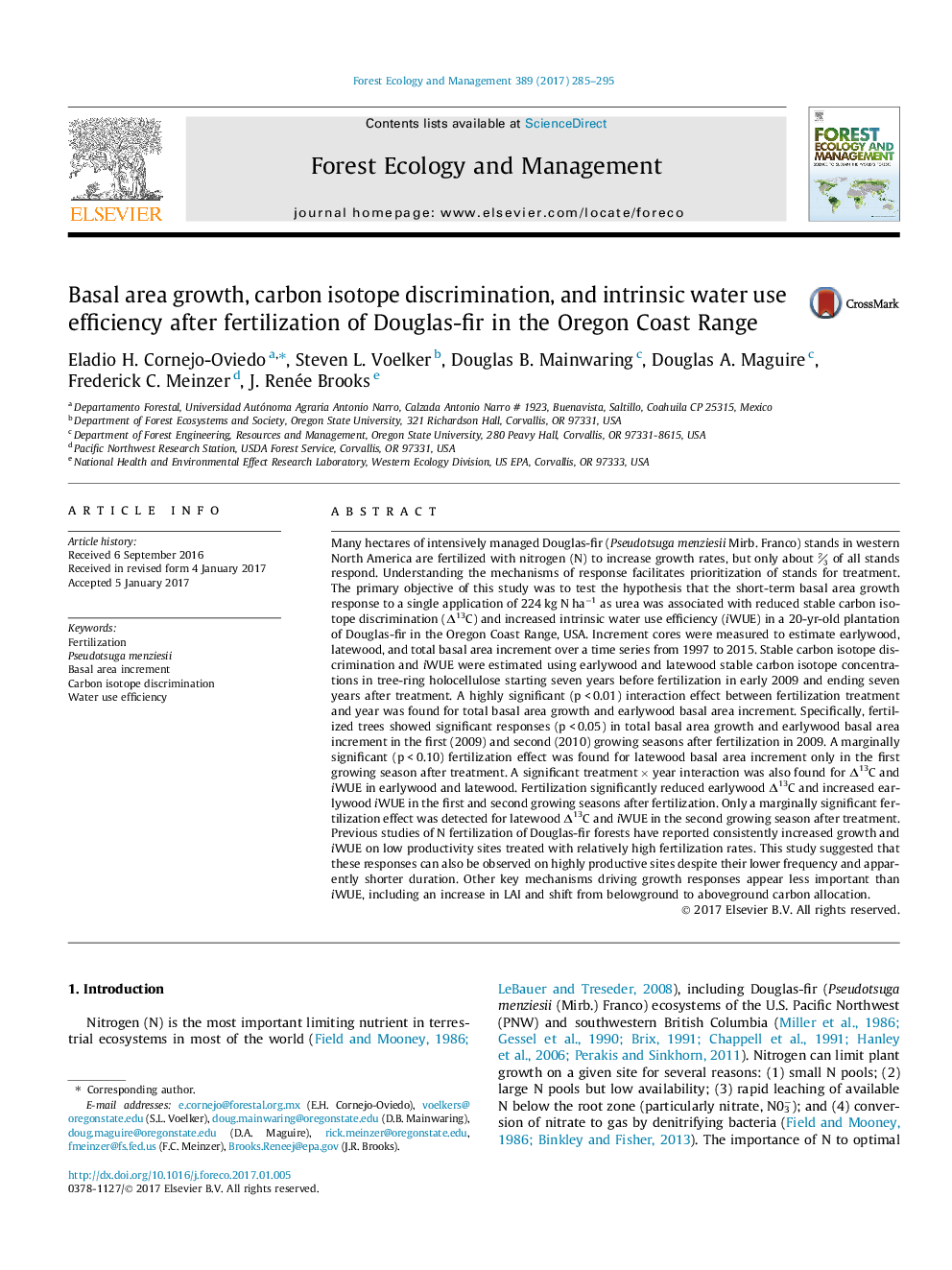| کد مقاله | کد نشریه | سال انتشار | مقاله انگلیسی | نسخه تمام متن |
|---|---|---|---|---|
| 4759510 | 1421369 | 2017 | 11 صفحه PDF | دانلود رایگان |
عنوان انگلیسی مقاله ISI
Basal area growth, carbon isotope discrimination, and intrinsic water use efficiency after fertilization of Douglas-fir in the Oregon Coast Range
دانلود مقاله + سفارش ترجمه
دانلود مقاله ISI انگلیسی
رایگان برای ایرانیان
کلمات کلیدی
موضوعات مرتبط
علوم زیستی و بیوفناوری
علوم کشاورزی و بیولوژیک
بوم شناسی، تکامل، رفتار و سامانه شناسی
پیش نمایش صفحه اول مقاله

چکیده انگلیسی
Many hectares of intensively managed Douglas-fir (Pseudotsuga menziesii Mirb. Franco) stands in western North America are fertilized with nitrogen (N) to increase growth rates, but only about â
of all stands respond. Understanding the mechanisms of response facilitates prioritization of stands for treatment. The primary objective of this study was to test the hypothesis that the short-term basal area growth response to a single application of 224 kg N haâ1 as urea was associated with reduced stable carbon isotope discrimination (Î13C) and increased intrinsic water use efficiency (iWUE) in a 20-yr-old plantation of Douglas-fir in the Oregon Coast Range, USA. Increment cores were measured to estimate earlywood, latewood, and total basal area increment over a time series from 1997 to 2015. Stable carbon isotope discrimination and iWUE were estimated using earlywood and latewood stable carbon isotope concentrations in tree-ring holocellulose starting seven years before fertilization in early 2009 and ending seven years after treatment. A highly significant (p < 0.01) interaction effect between fertilization treatment and year was found for total basal area growth and earlywood basal area increment. Specifically, fertilized trees showed significant responses (p < 0.05) in total basal area growth and earlywood basal area increment in the first (2009) and second (2010) growing seasons after fertilization in 2009. A marginally significant (p < 0.10) fertilization effect was found for latewood basal area increment only in the first growing season after treatment. A significant treatment Ã year interaction was also found for Î13C and iWUE in earlywood and latewood. Fertilization significantly reduced earlywood Î13C and increased earlywood iWUE in the first and second growing seasons after fertilization. Only a marginally significant fertilization effect was detected for latewood Î13C and iWUE in the second growing season after treatment. Previous studies of N fertilization of Douglas-fir forests have reported consistently increased growth and iWUE on low productivity sites treated with relatively high fertilization rates. This study suggested that these responses can also be observed on highly productive sites despite their lower frequency and apparently shorter duration. Other key mechanisms driving growth responses appear less important than iWUE, including an increase in LAI and shift from belowground to aboveground carbon allocation.
ناشر
Database: Elsevier - ScienceDirect (ساینس دایرکت)
Journal: Forest Ecology and Management - Volume 389, 1 April 2017, Pages 285-295
Journal: Forest Ecology and Management - Volume 389, 1 April 2017, Pages 285-295
نویسندگان
Eladio H. Cornejo-Oviedo, Steven L. Voelker, Douglas B. Mainwaring, Douglas A. Maguire, Frederick C. Meinzer, J. Renée Brooks,